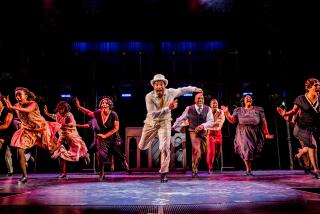STAGE REVIEW : âDining Roomâ Finds a Good Home in Pasadena
The Pasadena Playhouse. Of course. Thatâs where A. R. Gurneyâs âThe Dining Roomâ belongs.
When this comedy about the vanishing Northeastern WASP first appeared in the Los Angeles area in 1985, it was at the Coronet Theatre in West Hollywood. An unadorned stage in a New Money community, on a busy commercial street. Wrong, wrong, wrong.
The Pasadena Playhouse is an elegantly framed stage in an Old Money community, on a side street. Short of moving cast and audience to an equivalent theater in New England, the play could hardly have a more proper home. Fortunately, David Saintâs staging is worthy of its environs.
âThe Dining Roomâ examines the domestic life of Old Money types. People who still think about finger bowls at the dinner table, even if they no longer use them. People who never have to think much about how to pay the bills.
The structure of the play is not as conservative as its subject. Itâs a series of short sketches, each with different characters. From one scene to another, the characters share the same dining-room set, but there is no direct connection, no indication that they even know the people in the other scenes.
Before an episode ends, the next oneâs characters are likely to emerge in the background, so the two scenes overlap. But the characters from different stories donât notice each other--they might be living in completely different eras. Besides, their mothers taught them not to stare at strangers and their fathers taught them never to disclose how surprised they sometimes are. So even if they did notice the characters from another scene, chances are they would be very discreet about it.
This kind of reticence might thwart the dramatic impulse in lesser hands. But there is no lack of drama in âThe Dining Room.â Much of it is between the generations. Some of it is marital or extramarital. Some of it is between those who understand dining rooms, and those who donât.
Among those who really understand dining rooms are the people who wait on the tables, and gradually we see them leaving. They donât want to do domestic service any more.
We also see the dining rooms themselves being carved up or carted away. An architect, who clearly hated every minute he was in the dining room as he grew up, proposes converting it into a psychiatristâs office. A young student is interested in his auntâs dinner service--but only because heâs doing an anthropology project.
While this particular character may appear insensitive, Gurney was functioning as a kind of anthropologist himself. His gaze is gentle but penetrating; he peers into his charactersâ inner lives with an unclouded eye.
Yet there is nothing academic about his work. Many of his scenes are like live-action New Yorker cartoons.
The broadness of the caricature varies from scene to scene, but there are laugh-out-loud moments in nearly all of them.
Each actor plays nine or 10 roles. The age range of the characters is much wider than that of the cast. Adults who play kids can get irritating, but in this case, the brevity of the scenes and their comic flavor allows us to suspend disbelief long enough to make allowances. In only one brief moment, when Conrad Bain is allowed to lisp one of the kidsâ lines, is that delicate balance upset.
At the other end of the age spectrum, Bain is perfect as two old-timers, and relatively young Amanda Carlin treats the very oldest character with as much accuracy and respect as she brings to the birthday girl in a kid scene or the mixed-up young mom who wants to return to the nest.
The only scene thatâs not quite up to snuff is one with Carlin and Mark Arnott as a husband and wife, arguing over whether she can place her typewriter on the sacred table. Arnott is a bit too restrained here, but later his restraint is superb as father to Carlinâs aforementioned mixed-up daughter, and as son to Bainâs funeral-preparing father.
Debra Mooney and Arnott create ample sexual tension as a divorced table owner and the carpenter who comes to check out the tableâs underside, and Mooney has a sharp edge as a mother accused of adultery by her son.
Anne Swift is equally funny as a harried mom and a blase teen-ager. And when Reed Birney works up a delicious snit as Standish, the upright defender of his âbachelorâ brotherâs honor, Swift supports her husbandâs quest with high style.
Douglas D. Smithâs set isnât quite in the void described in the Gurney text; we can see a staircase outside the dining room. Nor does Michael Gilliamâs lighting change quite as much as Gurney suggested. But itâs nonetheless a handsome package for Gurneyâs ironic evocation of a fading culture.
âThe Dining Room,â Pasadena Playhouse, 39 S. El Molino Ave., Pasadena, Tuesdays-Fridays, 8 p.m.; Saturdays, 5 and 9 p.m.; Sundays, 2 and 7 p.m. Ends Aug . 25. $29. (818) 356-PLAY, (213) 480-3232. Running time: 2 hours, 15 minutes.
âThe Dining Roomâ
With Mark Arnott, Conrad Bain, Reed Birney, Amanda Carlin, Debra Mooney, Anne Swift
By A. R. Gurney. Directed by David Saint. Set by Douglas D. Smith. Lighting by Michael Gilliam. Costumes by Ann Bruice. Production stage manager Kathleen Horton. Stage manager Cheri Catherine Cary.
More to Read
The biggest entertainment stories
Get our big stories about Hollywood, film, television, music, arts, culture and more right in your inbox as soon as they publish.
You may occasionally receive promotional content from the Los Angeles Times.










